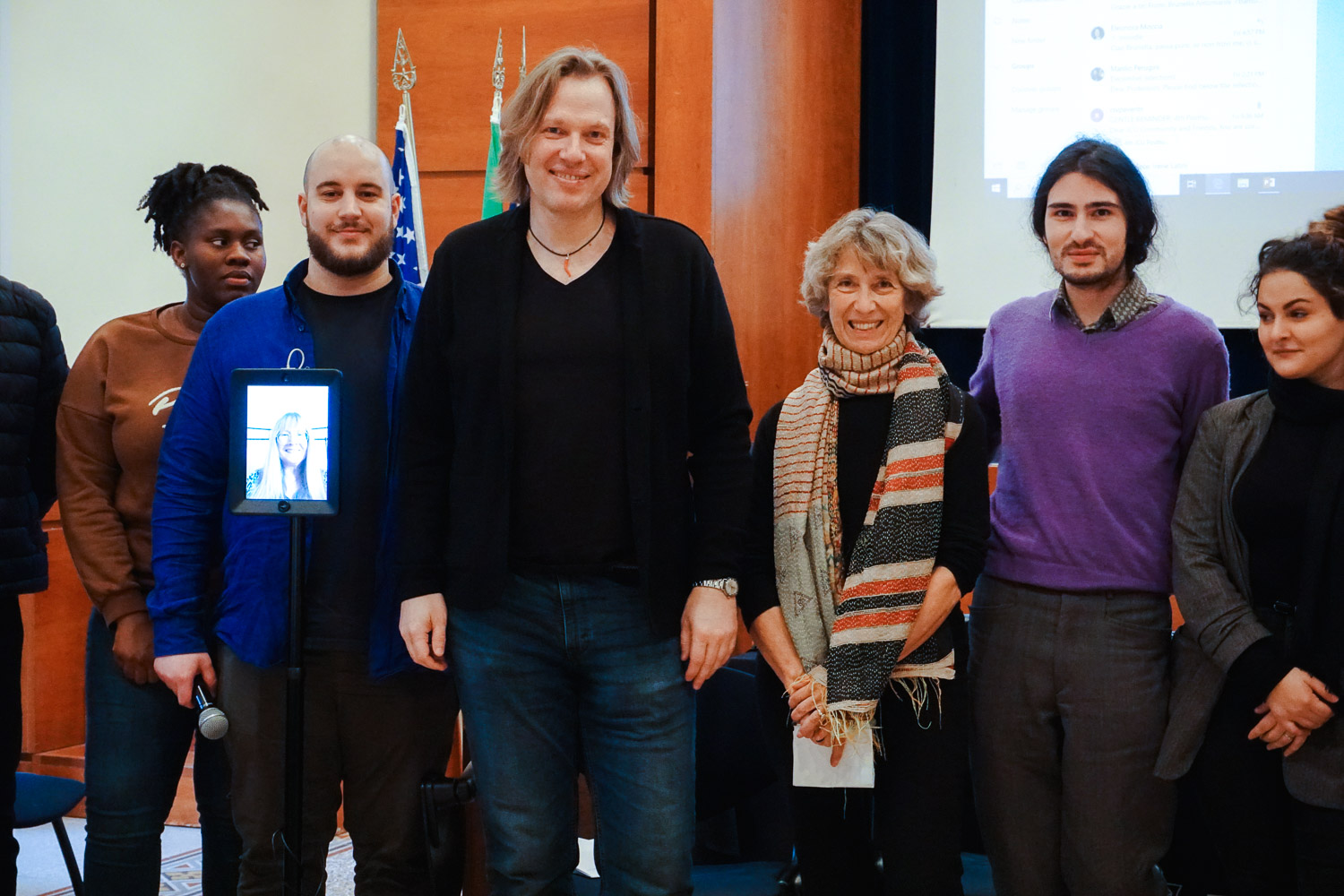Sex and Robots: JCU Hosts 4th Posthuman Studies Workshop
John Cabot University hosted a workshop called “Sex in Posthuman Times,” which tackled various topics like sex robots, sexuality, deep porn, and agency, on February 1, 2020. The day-long workshop, fourth in the JCU Posthuman Studies Workshops series, was organized by philosophy professors Brunella Antomarini and Stefan Lorenz Sorgner.
The keynote speakers were philosopher Maurizio Balistreri (Università di Torino), and Dr. Trudy Barber (Portsmouth University).
The other speakers included Professor Tanja Kubes (Technical University of Munich), Mirko Garasic (researcher at the UNESCO Chair in Bioethics and Human Rights, and Bioethics Professor at LUISS), Christina Maraboutaki (Ph.D. candidate at Sapienza University of Rome and attorney-at-law), Chryssi Soteriades (English Literature senior), Ihsan Baris Gedizlioglu (Art History M.A. student), and Giulia Villanucci (Communications senior).
Sex robots
Sex robots are anthropomorphic robot sex dolls. Roxxxy, the first sex robot, was created in 2010 by “TrueCompanion,” a New Jersey-based company. Her physical features could be customized according to personal preferences, and she had an artificial intelligence that could be programmed by her owner.
In 2017, a more advanced sex doll called Harmony, who could smile, blink and frown, was created by Realbotix’s founder Matt McMullen. Harmony could hold a conversation, tell jokes, remember food preferences, and the names of her owner’s siblings. In 2018, the first male sex robot, called Henry, was introduced by Realbotix.
Both Harmony and Henry can be fully customized according to the owner’s preferences. Moreover, they are advertised as companions with whom one can form meaningful connections, and who can provide emotional support. However, sex robots are quite expensive, as their price ranges from $3,500 to more than $10,000, therefore they are still not very common. According to an online survey carried out in 2017 by Statista, among 1,136 people over the age of 18, 46% of males and 63% of females said that they “definitely wouldn’t consider” having sex with a robot.
The question of personhood in sex robots
Should sex robots be considered as persons? In the future, the demand for sex robots might increase, in which case some kind of regulation might be necessary. But if sex robots are eventually granted the status of personhood and have the same rights as a person, then their use as sexual companions might have to be reconsidered. If sex robots are to be considered people, then they can’t be forced to have sexual relationships. “We can grant personhood to robots if/when they are able to participate in the construction of the rules, or juridical laws,” said Professor Antomarini.
“I think there is the possibility that personhood ought to be granted to embodied A.I.s, i.e. computers with sensors if they are capable of perceiving cognitive pain. In such circumstances, a certain type of personhood would have to be granted to such robots. The consequences would have to depend on the intensity of the pain they can have, i.e. on the relationship between their ability to experience pain in comparison to that of other persons. Consequently, we need to establish empirical ways to analyze the capacity of different entities to experience pain, which is a challenging task,” said Professor Sorgner.
Sex and Love with Robots – Pros and Cons
Keynote speaker Maurizio Balistreri gave a presentation called “Sex and Love with Robots,” which focused on the moral implications of sex robots. The two main objections are that people who have sex with robots are immoral, and that sex robots are a danger for women.
As for the belief that people who have sex with robots are immoral, Balistreri highlighted the fact that there are different reasons as to why one would choose to engage in this activity. Some people simply want to have sexual relationships without the attachment that comes with being involved with a person. Others use sex robots because they might be in a long-distance relationship and want to have sexual encounters without cheating on their partner.
An argument in favor of sex robots is that they could help satisfy the needs of people with physical and mental disabilities, or elderly people who suffer from neurodegenerative diseases.
The idea that sex robots could be a danger for women is advanced by Kathleen Richardson of De Montfort University in Leicester, England, who created the “Campaign Against Sex Robots.” According to Richardson, sex robots “are potentially harmful and will contribute to inequalities in society.” She believes that sex robots promote the exploitation and objectification of women, who could eventually be replaced by them. Moreover, Richardson believes that sex robots could be dangerous for men too, as they would no longer be able to relate to women effectively. For Richardson, the only way to protect women is to ban the production of sex robots.
However, some argue that sex robots might help reduce the exploitation of women by entering the sex market and replacing sex workers.
Participants’ contributions
The workshop focused on the idea that sex robots might expand our sexual horizons, and that they might be an addition “to spice things up.” According to some participants, sex robots might help people unleash urges in specific contexts, but they might also bring long-term damage to relationships between two humans. Moreover, having sex with robots might be considered a form of auto-eroticism, or an “aid” since they are similar to sex toys.
However, engaging in sexual activities with robots might be harmful because it may cause an addiction. Furthermore, the sex robot might have manufacturing defects and could be problematic in terms of data protection. The prospects of sexless reproduction or the idea of creating children in a lab as a possible future development were also discussed.
Deep porn
The term “deep porn” comes from “deepfake,” the practice of manipulating videos to show fabricated images and sounds that appear to be real. Simply put, deepfake videos superimpose someone’s face on top of someone else’s. Deepfakes are used, among other things, to create pornographic videos, hence the term deep porn. Oftentimes, celebrities are the ones whose faces are used in deep porn. A celebrity who is a constant target of deep porn videos is actress Kristen Bell.
Student Giulia Villanucci delivered a presentation called “Harmful Deep Porn in an Era of Taboos,” where she discussed the moral, social and legal sanctions that deep porn can cause, and she concluded by asking whether or not limits should be set.
New sexual identity
The second keynote speaker was Dr. Trudy Barber, Media Studies professor at Portsmouth University, who attended the workshop in telepresence. For Barber, the advent of sex robots was a result of people’s continued immersion in technology, and she suggested that in the future, sex with robots could be considered a new type of sexual identity.
According to Barber, we are creating our own sexuality, which is becoming increasingly fluid. The sexual practices that are considered deviant today, could be perceived as innovative in the future.






